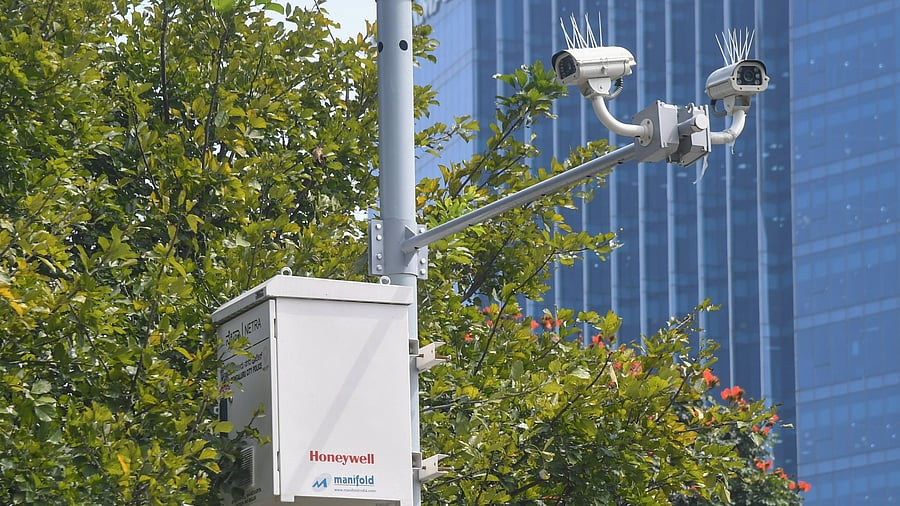
Cameras to catch traffic violations under ITMS at Hudson Circle in Bengaluru.
Credit: DH file photo
Bengaluru: Artificial Intelligence (AI) cameras installed under the Intelligent Traffic Management System (ITMS) in Bengaluru have only a 75 per cent-80 per cent accuracy in catching non-helmet rule violations, a painful realisation that has prompted the Bengaluru Traffic Police to launch a drive to rectify the inaccuracies.
The move may lead to a dip in the number of violations detected by the advanced cameras as the traffic police have begun manually rechecking all violations to weed out the errors flagged by the system.
The drive launched by the traffic department, deploying as many as 18 people for the job, is a fresh reminder of the limitations of the much-hyped AI technology, which is slowly seeping into several critical areas of the economy.
In 2023, a whopping 87.47 lakh traffic violations — out of a total of 89.99 lakh — were detected through contactless means. A majority of these (53.8 lakh) involved violations of the helmet-wearing rule, followed by jumping signals, not wearing seat belts and others.
Cameras installed under the ITMS detected a major share of the violations. But the traffic police soon realised something was amiss and came to a sobering conclusion that the system was not foolproof.
M N Anucheth, Joint Commissioner of Police (Traffic), Bengaluru, said the ITMS had a 97 per centaccuracy in detecting no-helmet violations. But the system's record plummeted when it came to other violations, displaying only about 75 per cent-80 per cent accuracy.
This meant that one in four or five violations recorded by the system were probably inaccurate.
The traffic police chief scrambled to fix the error before it metastasizes into a trust problem. Since Dec 8, Anucheth set aside a team of 18 people — teams of six working in three shifts — to recheck all violations detected by the ITMS since November 2022.
"They have reached till July 2023. They will require two to three months to complete the rechecking of violations," he said.
Besides this, there is also a team of five officers validating each violation currently flagged by the cameras. Although the throughput, or the number of cases processed in a fixed period, has fallen from 14,000 automated detections to about 8,000 to 9,000 cases, Anucheth doesn't mind.
Following the completion of the rechecking process, the team of 18 will validate real-time violation detection.
This, Anucheth said, is an attempt to make the system more transparent and less prone to errors. "I want the system to have integrity and transparency; it should be trustworthy. If people don't trust the system, then it is a huge issue," he said.
He added that since the algorithms are not perfect, working with AI through this manner is one way of ensuring that it acts as a "force multiplier".
This will also clear any concerns raised by citizens about wrongly issued challans since most, if not all, of them issued in the past year will be cleared in the system.
Highlights - A system's limitations In 2023, 87.47 lakh traffic violations out of a total of 89.99 lakh detected through contactless means A majority of these (53.8 lakh) involved violations of the helmet-wearing rule, followed by jumping signals Cameras installed under the Intelligent Traffic Management System detected a major share ITMS had 97 per cent accuracy in detecting no-helmet violations, but displayed only about 75 per cent-80 per cent accuracy in others This meant one in four or five violations recorded are probably inaccurate